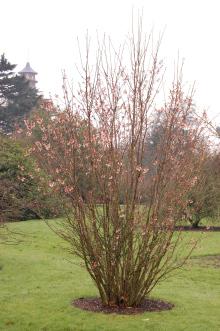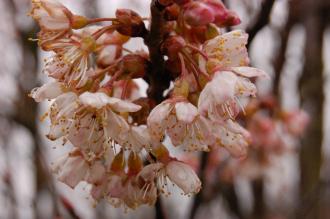
Prunus nipponica var kurilensis (23/03/2013, Kew Gardens, London)
Position: Full sun to light shade
Flowering period: Spring
Soil: Moist, well drained
Eventual Height: 4m
Eventual Spread: 2m
Hardiness: 5a, 5b, 6a, 6b, 7a, 7b, 8a, 8b, 9a, 9b
Family: Rosaceae
Prunus nipponica var kurilensis is a deciduous spring flowering small tree or large shrub. Its dark green leaves are ovate to lanceolate with a serrate margin and up to 13cm long and 6.5cm wide. Its leaves turn orange/ red in autumn before they fall. Its pale pink flowers are borne singly, or in umbels of two to six. Its red/ black fruit is a spherical drupe and up to 7mm across.
Prunus nipponica var kurilensis, commonly known as the Japanese Alpine Cherry or Kurile Cherry, is native to east Russia, east Asia and Japan
The etymological root of the binomial name Prunus is from the classical name of the Plum tree. Nipponica is a Latinised form of the former name for Japan, Nippon. Kurilensis refers to the provenance of this tree, the Kuril Islands, a string of Russian islands off north Japan.
The landscape architect may find Prunus nipponica var kurilensis useful as a small spring flowering tree.
Ecologically, Prunus nipponica var kurilensis flowers are attractive to pollinating insects. Its fruit are attractive to some birds and mammals.

Prunus nipponica var kurilensis Flower (23/03/2013, Kew Gardens, London)
Prunus nipponica var kurilensis prefers moist, fertile, well-drained soils. It tolerates most pH of soil.
Prunus nipponica var kurilensis requires little maintenance. Pruning should be carried out after flowering, from April to July to minimise the risk of Silver leaf infection.

